Metaphors
A metaphor is a word or a phrase used to describe something as if it were something else; a figure of speech that, for rhetorical effect, directly refers to one thing by mentioning another. It may provide clarity or identify hidden similarities between two different ideas. Metaphors are usually meant to create a likeness or an analogy.
Merriam Webster:
Metaphor is a figure of speech in which a word or phrase literally denoting one kind of object or idea is used in place of another to suggest a likeness or analogy between them (as in drowning in money) broadly : figurative language compare simile. 2. : an object, activity, or idea treated as a metaphor : symbol sense 2.
As BBC Bitesize puts metaphor:
For example:
- A wave of terror washed over him.
The terror isn’t actually a wave, but a wave is a good way of describing the feeling.
- Jess is dynamite.
She’s not made of dynamite, but it’s a way to explain how exciting she is.
[A Simile is a figure of speech that compares two otherwise dissimilar things, often employing the words like or as (‘cheeks like roses’). A metaphor is a figure of speech in which a word or phrase that has one literal meaning is applied to another thing in order to suggest a likeness or similarity between the two (‘the baby’s cheeks were newly bloomed roses’)]
Metaphors in Science
Metaphors are pervasive in the language of science. Scientists regularly engage in analogical reasoning to develop hypotheses and interpret results, and they rely heavily on metaphors to communicate observations and findings.
Aristotle claimed that “the greatest thing by far is to be a master of metaphor; it is the one thing that cannot be learnt from others; and it is also a sign of genius, since a good metaphor implies an intuitive perception of the similarity in the dissimilar.”
See: https://thebiologist.rsb.org.uk/biologist-features/master-your-metaphors
Metaphor of Trees
Trunk, roots, branches, branchlets, roots.
The TREE metaphor is widespread in many domains. Representing spreading connections – it has inspired many to adopt their form in a wide variety of knowledge representations e.g. the biological classifications of Aristotle and Darwin, and lineage in family trees. It is the perfect architectural metaphor for the building’s elements.
Ways of representing the hierarchical nature of a structure in a graphical form.
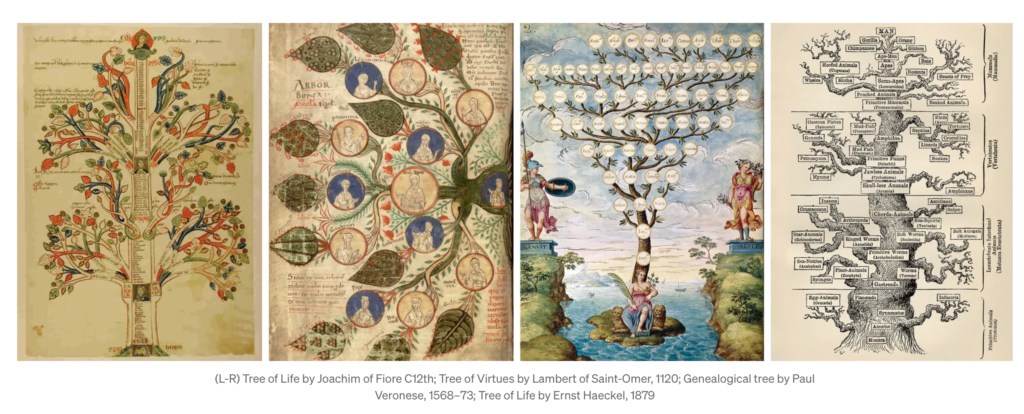
Turn the tree upside down!
The Trunk =/= The Focus Class Type
The Branches =/= The Instances Sub Classes Subtypes
The Roots =/= Context Superclass
DO NOT turn the tree upside down!
The Trunk =/= The Focus, Class Type
The Branches =/= Context, Superclass
The Roots =/= The Instances, Sub Classes, Subtypes
A simple hierarchy with levels of decomposition//fragmentation from big to medium to small; from system to component, to molecular, to atomic.




[From: ‘The Society of Mind’, Marvin Minsky Simon & Schuster New York]
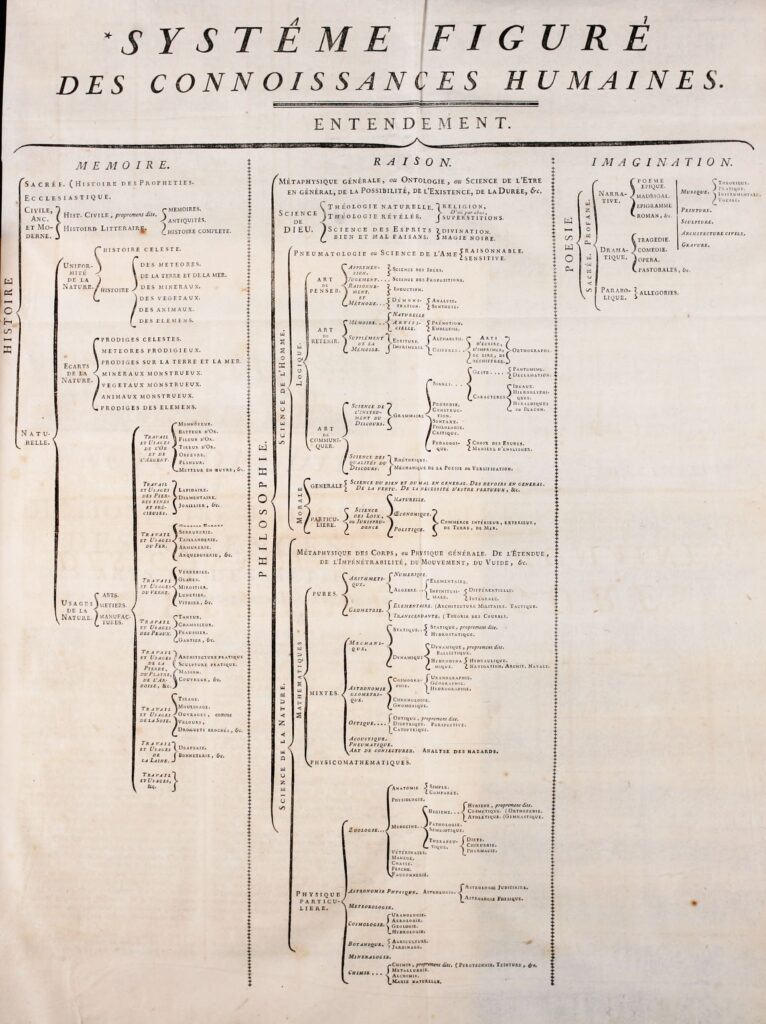
The original Encyclopedie (1752) used a tree diagram to show the way in which its subjects were ordered [Wikipedia, Tree Structure]
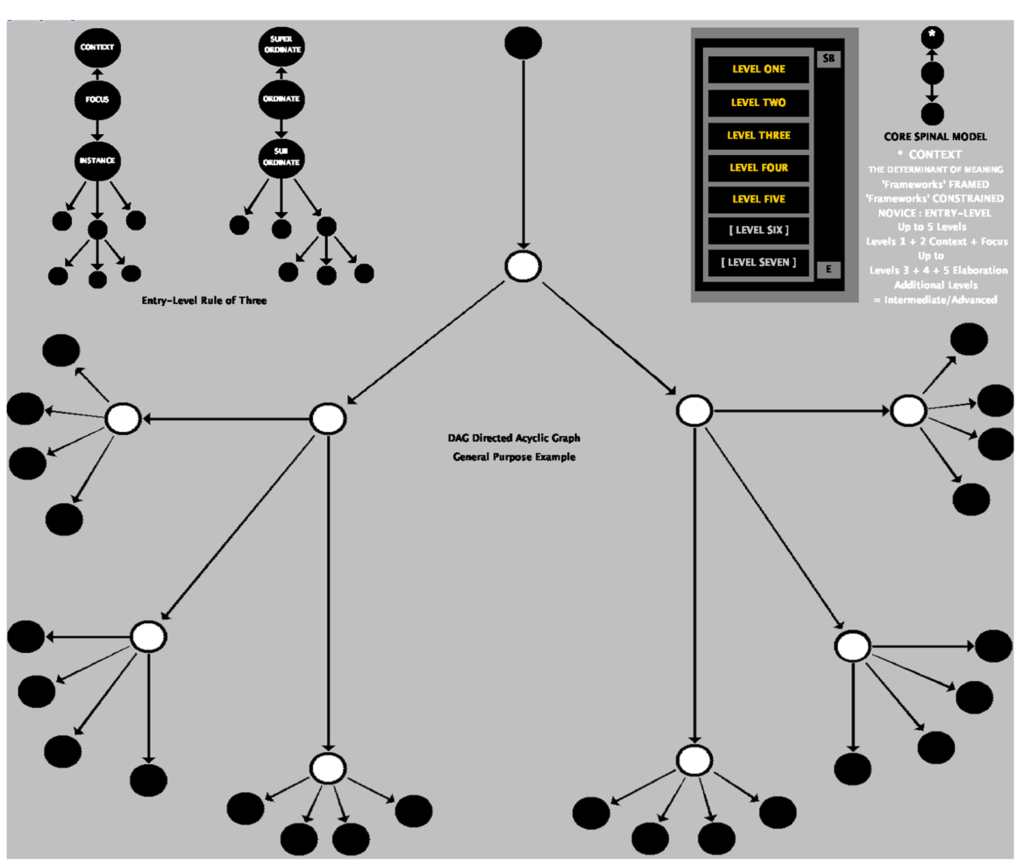
Representation of simple Directed Acyclic Graph Tree Structure – and the simple Core Spinal Model of ‘Frameworks’.
See: ‘Frameworks’ a Simple Methodology for Structured Thinking p. 209, Section 6 Summary; published with the assistance of Brandspire Books
Pyramids
Hierarchical models may be depicted as pyramids.

The pyramid graphic here is employed to depict the hierarchy of the ‘Frameworks’ Core Spinal Model of Context (superclass), Focus (Class) and Instances (Sub Classes) – the ‘Pyramid of Numbers’ – and the Levels of Hierarchy in ‘Frameworks’ Modelling. The Methodology provides for ‘Framed” and “Constrained” Modelling. Three Levels of Modelling may be exercised: ‘Novice’, ‘Intermediate’ and ‘Advanced’.
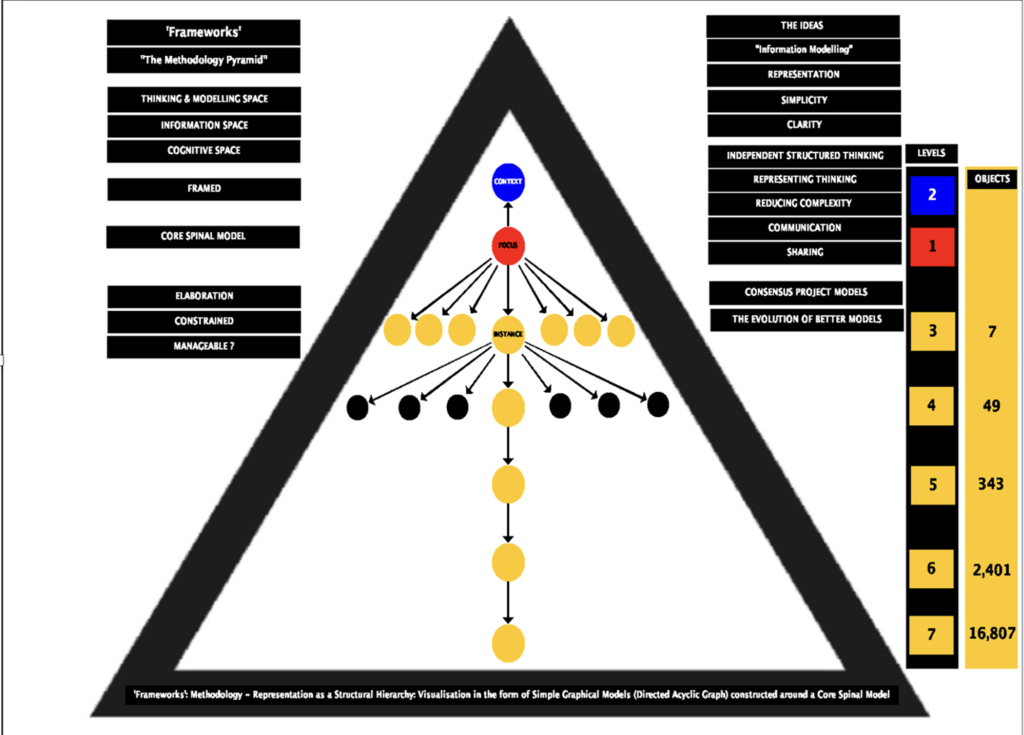
The ‘Frameworks’ Pyramid of Numbers is a visualisation of the ‘Frameworks’ Methodology – framed and constrained – where the key idea is the simple analysis of large and complex entities (systems, domains, sets of ideas) deriving a minimal model composed of the fewest key elements. And the idea of information model hierarchies – constructed and elaborated around a simple Core Spinal Model – with Context and
Focus at the two top levels, with additional levels of hierarchy beneath.
Entry-Level Modelling (Novice) where decomposition and modelling are constrained to X 3 (Nodes may be decomposed into up to 3 additional nodes and up to x 3 additional levels of hierarchy); Intermediate-Level where decomposition and modelling are constrained to X 5 (Nodes may be decomposed into up to 5 additional nodes and up to x 5 additional levels of hierarchy); and Advanced-level Modelling where decomposition and modelling are constrained to X 7 (Nodes may be decomposed into up to 7 additional nodes and up to x 7 additional levels of hierarchy)*.
*The logistics of Advanced-Level Modelling – in terms of cognitive load and display real estate – are rather challenging!
‘Frameworks’ as an Introduction & Entry-Level
Metaphors are important in communication and cognition because they express, reflect, and reinforce different ways of making sense of particular aspects of our lives. This central function of metaphor is itself often referred to metaphorically as ‘framing’.
The ‘Frameworks’ Methodology has been distilled out in the form of the ‘Frameworks’ Meta Model and ‘Frameworks’ Prototype Tool, “The Intelligent Frame”.
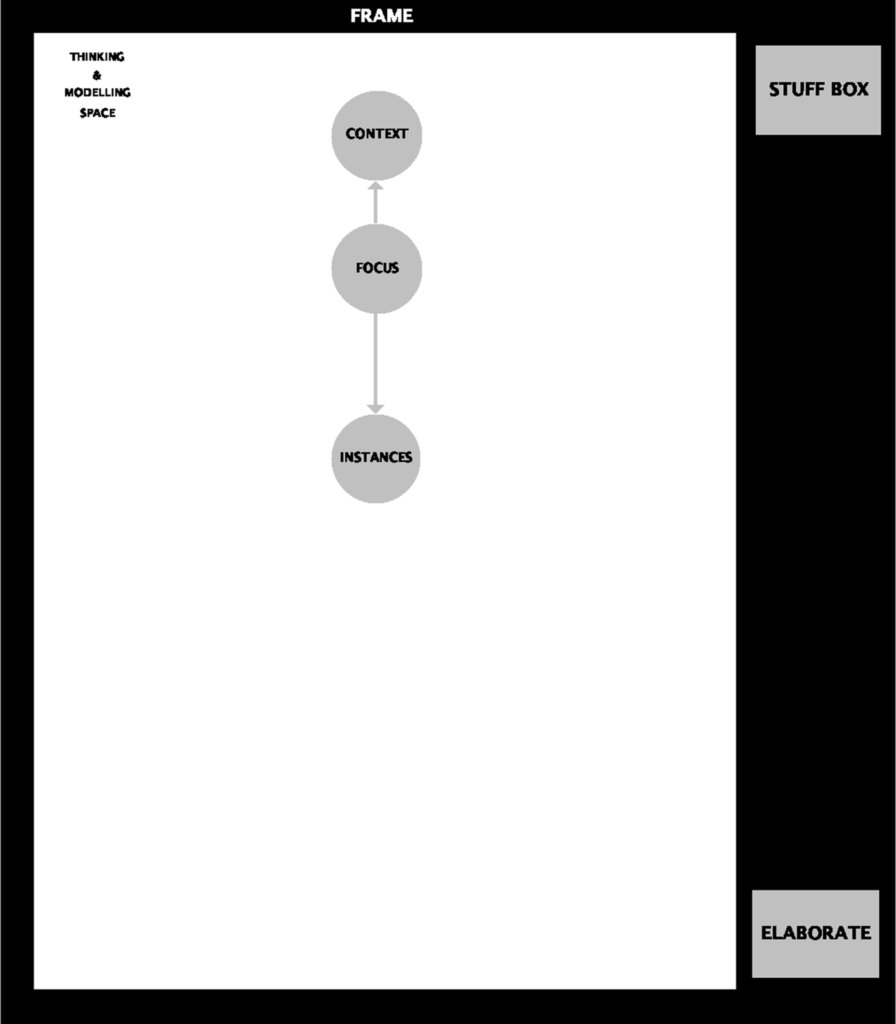
The ‘Frameworks’ Meta Model – where the Thinking & Modelling Space is “framed”; where models are constructed around the ‘Frameworks’ Core Spinal Model of Focus, Context and Instances.
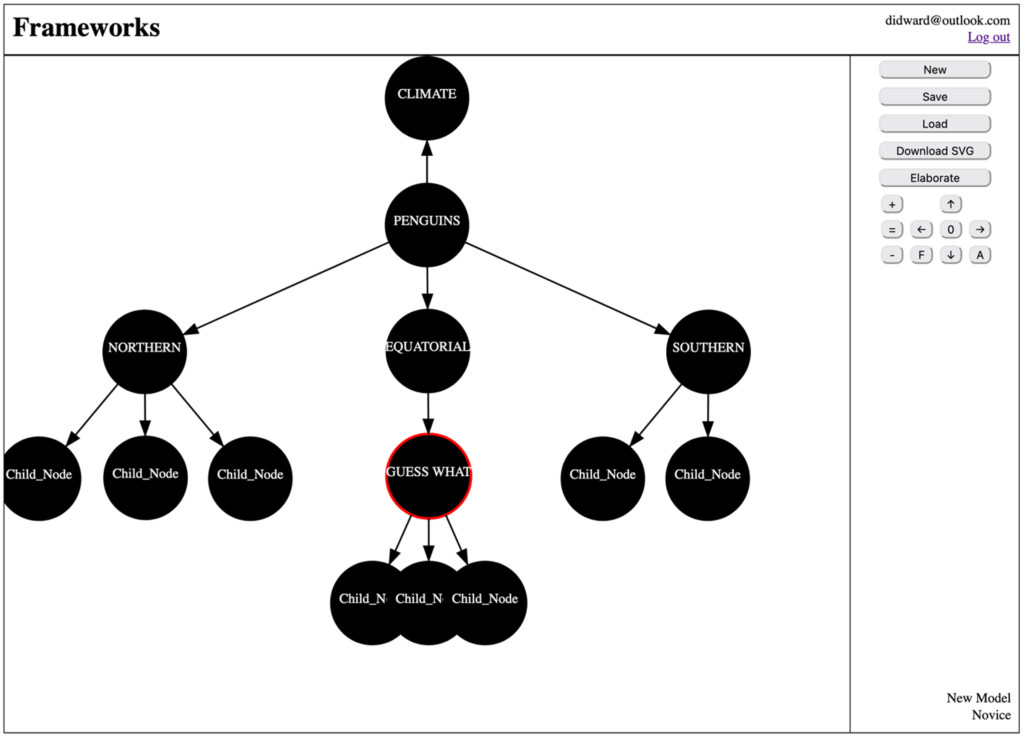
The ‘Frameworks’ Tool: where modelling is “framed”, “constrained” and rule-based.
‘Frameworks’ is an introduction* to the concept and ideas around reducing complexity to manageable proportions through decomposition, analysis and naming, sorting, categorisation and modelling: organising things and categories of things in a meaningful array.
*an entry-level to dealing with scale and complexity in domains and systems; a good starting point – where professional systems analysts engage in more sophisticated analysis and modelling and use advanced and sophisticated enterprise architecture tools such as ‘Ardoq’.
See: https://www.ardoq.com/
